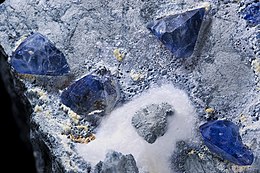| Benitoite | |
|---|---|
 Benitoite on natrolite | |
| General | |
| Category | Cyclosilicate |
| Formula (repeating unit) | BaTiSi3O9 |
| IMA symbol | Bni[1] |
| Strunz classification | 9.CA.05 |
| Crystal system | Hexagonal |
| Crystal class | Ditrigonal dipyramidal (6m2) H-M symbol: (6 m2) |
| Space group | P6c2 |
| Unit cell | a = 6.641, c = 9.7597(10) [Å]; Z = 2 |
| Identification | |
| Color | Blue, colorless |
| Crystal habit | Tabular dipyramidal crystals, granular |
| Twinning | On {0001} by rotation |
| Cleavage | [1011] poor |
| Fracture | Conchoidal |
| Mohs scale hardness | 6–6.5 |
| Luster | Vitreous |
| Streak | White |
| Diaphaneity | Transparent to translucent |
| Specific gravity | 3.65 |
| Optical properties | Uniaxial (+) |
| Refractive index | nω = 1.756 – 1.757 nε = 1.802 – 1.804 |
| Birefringence | δ = 0.046 |
| Pleochroism | O = colorless; E = purple, indigo, greenish blue |
| Dispersion | 0.036–0.046[2] |
| Solubility | Insoluble: HCl, H2SO4 Soluble: HF |
| Other characteristics | Blue fluorescence under SW UV; intense blue cathodoluminescence |
| References | [3][4][5] |
Benitoite (/bəˈniːtoʊaɪt/) is a rare blue barium titanium cyclosilicate mineral, found in hydrothermally altered serpentinite. It forms in low temperature, high pressure environments typical of subduction zones at convergent plate boundaries. Benitoite fluoresces under short wave ultraviolet light, appearing bright blue to bluish white in color. The more rarely seen clear to white benitoite crystals fluoresce red under long-wave UV light.
It was discovered in 1907 by prospector James M. Couch in the San Benito Mountains roughly halfway between San Francisco and Los Angeles. Due to its similar color, Couch originally believed it to be sapphire, a variety of corundum. In 1909, a sample was sent to the University of California, Berkeley, where mineralogist Dr. George D. Louderback realized it was a previously unknown mineral. Corundum (sapphire) has a defined Mohs hardness of 9, while benitoite is much softer. He named it benitoite for its occurrence near the headwaters of the San Benito River in San Benito County, California.[6][7]
Benitoite occurs in a number of isolated locations globally, but gemstone quality material has only been found in California at the Benito Gem Mine where it was first discovered. It has been correctly identified in Montana, Arkansas, Japan, and Australia although they formed under slightly different conditions and only grow large enough to be considered an accessory mineral. In 1985 benitoite was named as the official state gem of California.[8][9]
Benitoite typically crystallizes hexagonally. Non-gem crystals of benitoite can have a very rare, six-pointed twinned form.[10]
- ^ Warr, L.N. (2021). "IMA–CNMNC approved mineral symbols". Mineralogical Magazine. 85 (3): 291–320. Bibcode:2021MinM...85..291W. doi:10.1180/mgm.2021.43. S2CID 235729616.
- ^ O'Donoghue, Matthew (2006). Gems: Their Sources, Descriptions and Identification (6th ed.). Oxford: Butterworth-Heinemann. p. 389. ISBN 978-0-75-065856-0.
- ^ WebMineral Listing
- ^ MinDat Listing
- ^ Cite error: The named reference
HBMwas invoked but never defined (see the help page). - ^ Louderback, George Davis (July 30, 1907). "Benitoite, A New California Gem Mineral". Bulletin of the Department of Geology. 5 (9). University of California Publications: 149–153. OCLC 6255540.
- ^ Wilkins, Al (March 23, 2002). "SCFM News March 02, Featuring Benitoite". Mineralogical Society of Southern California. Archived from the original on May 16, 2013. Retrieved April 3, 2014.
- ^ "Mineral Resources". California Department of Conservation - California Geological Survey. Archived from the original on August 21, 2008. Retrieved April 3, 2014.
- ^ "Benitoite". Gemology Online. Retrieved 8 November 2012.
- ^ Laurs, Brendan; Rohtert, William; Gray, Michael (Fall 1997). "Benitoite from the New Idria District, San Benito County, California" (PDF). Gems & Gemology. 33 (3). Gemological Institute of America: 173. doi:10.5741/GEMS.33.3.166. ISSN 0016-626X.